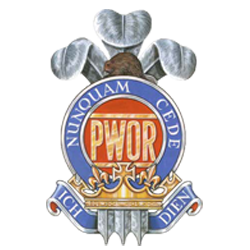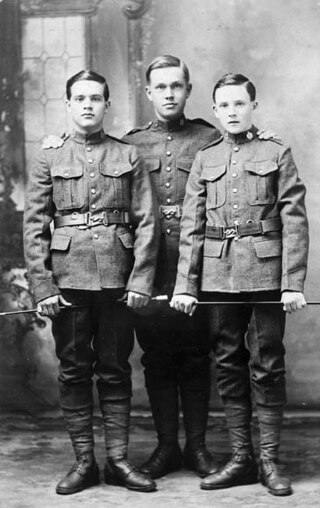Related Research Articles

The Princess of Wales' Own Regiment (PWOR) is a Primary Reserve infantry regiment of the Canadian Army.

The 236th Battalion, CEF was a unit in the Canadian Expeditionary Force during the First World War. Based in Fredericton, New Brunswick and Camp Valcartier, the unit began recruiting in the Spring of 1916 throughout Canada and the New England region in the United States of America. After sailing to England in November 1917, the battalion was absorbed into the 20th Reserve Battalion, CEF in March, 1918. The 236th Battalion, CEF was also known as the "MacLean Kilties of America" or "Sir Sam's Own".

The 29th Battalion (Vancouver), CEF was an infantry battalion of the Canadian Expeditionary Force during the Great War.
The 37th Battalion, CEF, was an infantry battalion of the Canadian Expeditionary Force during the Great War.
The 86th Battalion, CEF was an infantry battalion of the Canadian Expeditionary Force, which was raised for overseas service during World War I. Authorized on December 22, 1915, the battalion embarked for Britain in May 1916. Based at Shorncliffe, the battalion was reorganized as the Canadian Machine Gun Depot, CEF and provided reinforcements for Canadian units in the field until it was disbanded on 1 September 1917. It is believed to have been "the first of its kind in the British Empire."

The 21st Battalion, CEF was an infantry battalion of the Canadian Expeditionary Force in the Great War.
The 32nd Battalion, CEF, was an infantry battalion of the Canadian Expeditionary Force during the Great War.
The 33rd Battalion, CEF, was an infantry battalion of the Canadian Expeditionary Force during the Great War.
The 45th Battalion (Manitoba), CEF, was an infantry battalion of the Canadian Expeditionary Force during the Great War.

The 48th Battalion, CEF, was an infantry battalion of the Canadian Expeditionary Force during the Great War.
The 57th Battalion (Canadien-Français), CEF was an infantry battalion of the Canadian Expeditionary Force during the Great War. The 57th Battalion was authorized on 20 April 1915 and embarked for Britain on 2 June 1916. On 8 June 1916, its personnel were absorbed by the 69th Battalion, CEF to provide reinforcements to the Canadian Corps in the field. The battalion was disbanded on 11 April 1918.
The 61st Battalion (Winnipeg), CEF was an infantry battalion of the Canadian Expeditionary Force during the Great War. The 61st Battalion was authorized on 20 April 1915 and embarked for Great Britain on 5 April 1915. It provided reinforcements to the Canadian Corps in the field until 6 July 1916, when its personnel were absorbed by the 11th Reserve Battalion, CEF. The battalion was subsequently disbanded on 17 July 1917.

The 62nd Battalion, CEF was an infantry battalion of the Canadian Expeditionary Force during the Great War. The 62nd Battalion was authorized on 20 April 1915 and embarked for Britain on 20 March 1916. It provided reinforcements for the Canadian Corps in the field until 6 July 1916 when its personnel were absorbed by the '30th Reserve Battalion, CEF'. The battalion was subsequently disbanded on 8 December 1917.
The 76th Battalion, CEF was an infantry battalion of the Canadian Expeditionary Force during the Great War. The 76th Battalion was authorized on 10 July 1915 and embarked for Great Britain on 23 April 1916. It provided reinforcements to the Canadian Corps in the field until 6 July 1916, when its personnel were absorbed by the 36th Battalion, CEF. The battalion was subsequently disbanded on 17 July 1917.

The 77th Battalion (Ottawa), CEF was an infantry battalion of the Canadian Expeditionary Force during the Great War. The 77th Battalion was authorized on 10 July 1915 and embarked for Great Britain on 19 June 1916. It provided reinforcements for the Canadian Corps until 22 September 1916, when its personnel were absorbed by the 47th Battalion, CEF and the 73rd Battalion, CEF. The battalion was then disbanded.
The 90th Battalion, CEF, was an infantry battalion of the Great War Canadian Expeditionary Force. The 90th Battalion was authorized on 22 December 1915 and embarked for Great Britain on 31 May 1916, where on 19 July 1916 its personnel were absorbed by the 11th Reserve Battalion, CEF, to provide reinforcements to the Canadian Corps in the field. The battalion disbanded on 1 September 1917.

The 93rd Battalion (Peterborough), CEF, was an infantry battalion of the Great War Canadian Expeditionary Force. The 93rd Battalion was authorized on 22 December 1915 and embarked for Britain on 15 July 1916 where the battalion provided reinforcements to the Canadian Corps in the field until 6 October 1916, when its personnel were absorbed by the 39th Battalion, CEF. The battalion disbanded on 21 May 1917.
The 96th Battalion, CEF, was an infantry battalion of the Great War Canadian Expeditionary Force. The 96th Battalion was authorized on 28 November 1915 and embarked for Britain on 27 September 1916, where its personnel were absorbed by the 92nd Battalion, CEF to provide reinforcements for the Canadian Corps in the field. The battalion disbanded on 8 October 1916.

The 94th Battalion, CEF, was an infantry battalion of the Great War Canadian Expeditionary Force. The 94th Battalion was authorized on 22 December 1915 and embarked for Britain on 28 June 1916, where, on 18 July 1916, its personnel were absorbed by the 17th Reserve Battalion and the 32nd Battalion, CEF, to provide reinforcements for the Canadian Corps in the field. The battalion disbanded on 27 July 1918.
The 98th Battalion, CEF, was an infantry battalion of the Great War Canadian Expeditionary Force. The 98th Battalion was authorized on 22 December 1915 and embarked for Britain on 16 July 1916, where the battalion provided reinforcements to the Canadian Corps in the field until 6 October 1916, when its personnel were absorbed by the 12th Reserve Battalion, CEF. The battalion disbanded on 17 July 1917.
References
- ↑ Canadian Forces Publication A-DH-267-003 Insignia and Lineages of the Canadian Forces. Volume 3: Combat Arms Regiments.
- 1 2 3 Meek, John F. Over the Top! The Canadian Infantry in the First World War. Orangeville, Ont.: The Author, 1971. ISBN 0906158109
- ↑ "Canadian Army Reserve to inter colours". cknxnewstoday.ca. 2023-10-21. Retrieved 2023-10-23.
- ↑ "Community spotlight: Regimental colours interred in historic fashion at St. Thomas Cemetery". 94.1 St.ThomasToday.ca. Retrieved 2023-11-08.
- ↑ "91st Battalion Canadian Expeditionary Force Colours - National Inventory of Canadian Military Memorials (NICMM) - Memorials - Remembrance - Veterans Affairs Canada". www.veterans.gc.ca. 2019-02-20. Retrieved 2024-06-03.
- ↑ Canadian Forces Publication A-DH-267-003 Insignia and Lineages of the Canadian Forces. Volume 3: Combat Arms Regiments.